Buying a Campervan.
Campervans, campers, van conversions or ‘Dormobiles’ have been around for over a century. People soon figured out that the commercial van they had to use for work could also double up as a cheap holiday home.
The basis for a campervan has varied from the more traditional light commercial vehicles (LCVs) like the Ford Transit, Sevel vans (Fiat Ducato, Peugeot Boxer and Citroen Relay) or the venerable Volkswagen Transporter to the sublime. Conversions have been carried out on vehicles as small as the micro-sized vans manufactured by Vauxhall, Suzuki and Daihatsu.
Campers can be broadly split in to three main types – fixed roof, elevating roof or high top.
Fixed Roof


As the name suggests, these conversions are fitted in to a LCV with its normal tin roof left intact. There is insufficient internal height for an adult to stand up. However, the plus side is that this type of vehicle is likely to fit in your garage and under height barriers, allowing you to visit places others could not drive.
Elevating Roof
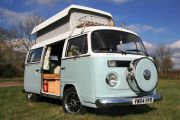
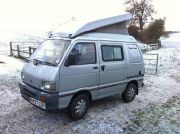

Again, pretty self explanatory, the convertor will cut an opening in the tin roof and affix an elevating structure which can be raised when on site. Some convertors use a solid sided elevating roof structure, most notably Auto-Sleepers, while more commonly a fabric sided mechanism is employed.
Roofs will also elevate in different manners, depending on convertor or customer choice. Some hinge at the front thereby creating standing room in the rear portion of the vehicle. Rear hinged versions create standing room at the front of the conversion. The side hinged roof is less popular nowadays and yet offers the best overall gain in space as it allows standing room for the length of the vehicle.
There are different designs of elevating roofs, even taking into account the front/rear/side hinge options. As you become familiar with conversions you will learn to differentiate between manufacturers. For example, the classic ‘Dormobile’ roof as designed by Martin Walter typically had a candy stripe canvas, was fitted with 2 opening roof windows in the fibre glass roof cap and was always side hinged.
Westfalia typically used a two piece moulding. The front cap covered the cab and provided luggage stowage. Initially their canvas sided elevating roof caps were hinged from the front but this changed in the early 1970s to a rear hinge.
High Top
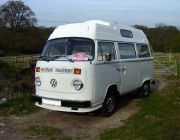
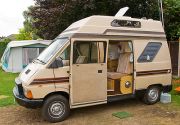
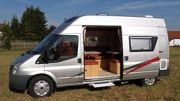
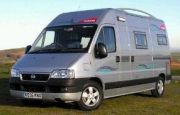
The name says it all. A convertor will either use the high top version of the vehicle or will cut an aperture and then bond a glass reinforced plastic (GRP) moulded high top on to the base vehicle.
In some cases the convertor will actually do both of these techniques. For example, Auto-Sleepers currently convert the modern Sevel LCV and use the factory high top model. However, to allow for a raised floor height and added insulation, Auto-Sleepers add an extra GRP roof cap to the high top to create more internal space.
With regards to longevity there is little to choose between a factory (steel) high top and a GRP addition. In fact, Volkswagen build their LT and T4 LCVs with a GRP roof cap as standard. It saves weight and is easier to repair than a steel one. Steel roofs can corrode over time unlike GRP. However, GRP can craze over time creating a weakened area.
Repairs on either steel or GRP require specialist skills, although neither are beyond a realitively experienced DIYer.
General Points - Structure
Some basic points are valid to all three of the above conversion types. As with coachbuilt motorhomes always look for DAMP. It is considerably less likely in a van conversion than a coachbuilt but it could still be there. Along side damp there is RUST to consider. Scrutinise any vehicle for rust, as you would if you were buying a normal car.
Different LCVs are prone to rust in different areas. The main points to check on ALL vehicles are the chassis, chassis rails, suspension points, arches, doors and scuttle panel (the panel between the windscreen and the bonnet). Classic VWs (1950 - 1979) tend to rust badly in the lower 9 inches of the body. This leads to corroded sills, chassis rails, steps, arches, etc etc. Later VWs from 1979 to 1990 (T25 model) tend to be more rust resilient. Where on the earlier models the rust can be hidden from view under the vehicle, the T25 tends to mainly rust in the panel seams and around the windows. These areas are easy to inspect. Still check underneath though to make sure its solid. The later T4 (1990-2003) and T5 (2003 to date) have a good reputation for being solid.

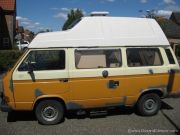
One of the most commonly used base vehicles in the 1980s and 1990s was the early Sevel van (Fiat Ducato, Citroen C25 and Talbot Express). All are identical in everything bar badges and one or two engine options. All also rust badly in the scuttle panel, wheelarches and bonnet.
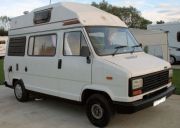
General Points - Conversions
The layout and conversion are something personal to the buyer and will be discussed in another section of the website. However, some general points about the conversion may help in your choice.
Check the fit of the furniture. Do cabinets still open and close properly or have they suffered from abuse by the user or due to poor manufacture? Even on high end models you may still find a 'Friday afternoon' situation where fitting out has been rushed and become shoddy.
Do the internal lights work? Does the water pump work? Can you see the pump (for servicing) and the pipework (in case of leaks)?
Check the bed mechanism works as it should and have the seller demonstrate it to you. Some models require a Krypton Factor style battle to find the correct pattern the cushions must be in to make a flat bed!
Check the appliances work.
Can you smell damp? Is there mold or mildew on the fabrics? Don't believe the old 'condensation' story. It maybe true but it may actually be that the window or roof rubbers are perished and letting rain in!
General Points - Base Vehicle
Check the vehicle has history with it. OK, on older models this may be harder but there should still be a full V5 (logbook), current MOT certificate and perhaps a service receipt.
Inspect all the tyres. Camper vans my be stood for lengthy periods. If the van has not been regularly moved you might get flat spots on the tyres. Worse still the tyre walls may well perish before the tread level drops to the point where the tyre needs replacing.
Have the seller show you all the lights, electronics, gizmos and gadgets before you make a decision. Do they all work? Does the air con cool down appropriately?
Regardless of the asking price it is higly advisable to get a credit and history check on any vehicle you are considering. HPI do checks that show any outstanding finance, insurance write-offs, change of colour and change of registration amongst other things. The cost is about £50 (at time of writing) but it could save you a fortune.
